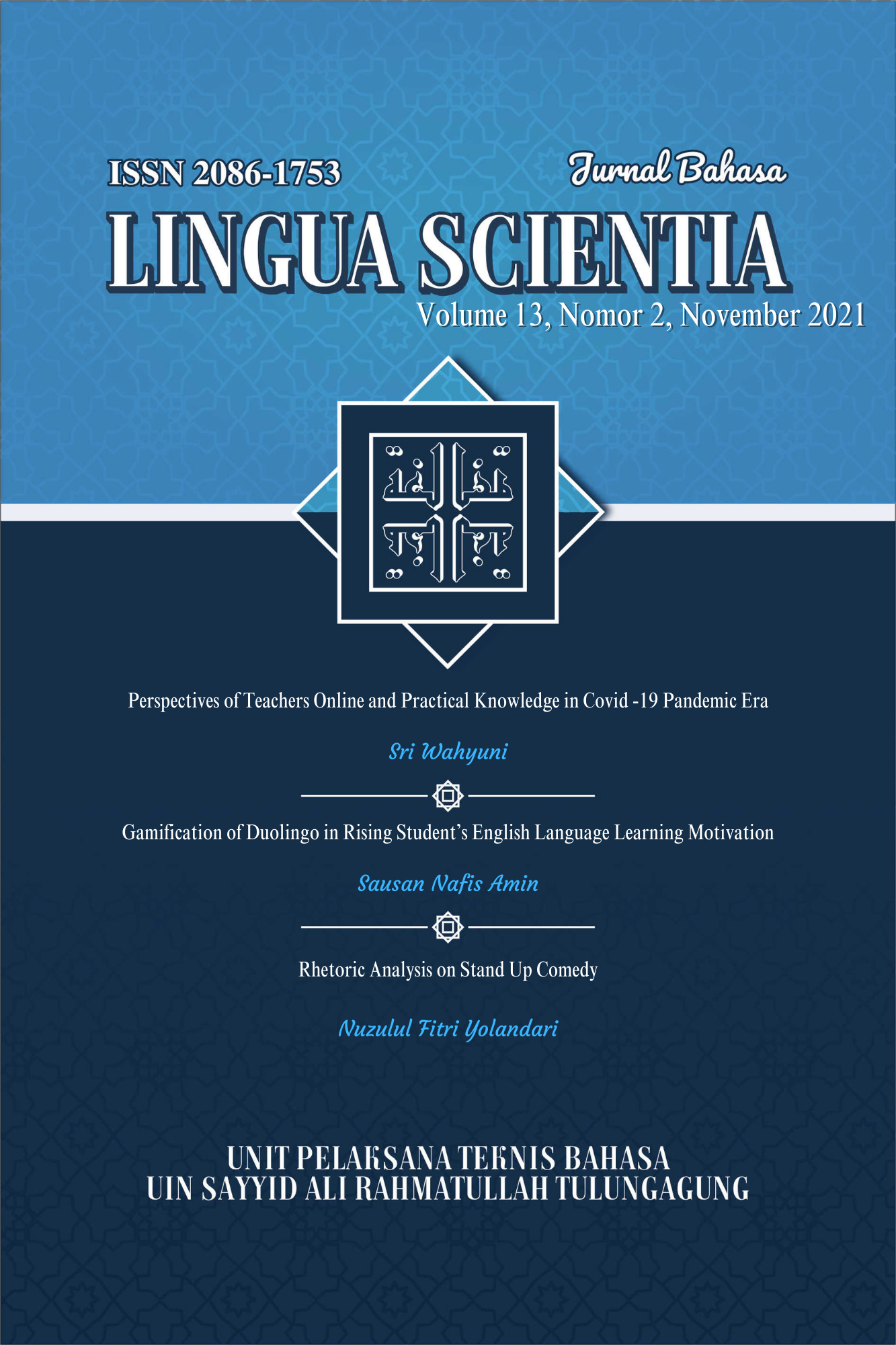OVERVIEW AND IDEAS FOR ORGANIZING AN ONLINE LANGUAGE CLASS
Abstract
Online language class can be set in two ways whether it uses a synchronous or asynchronous system. Due to the COVID-19 pandemic, the teaching-learning process is conducted online. Therefore, this paper does not only provide some overviews of the teaching-learning process in online English language classes (starting from providing an overview of the choices of a class setting, the tools and the reasons for their use, the challenges in conducting online language classes, the most applicable tools to use in online language classes) but also presents ideas covering four language skills to set online language classes in the post-pandemic era lively. This study uses convergent mixed method where questionnaires, interviews, and field notes are collected at roughly the same time to provide a comprehensive analysis of the research problem. The findings show a combination of synchronous and asynchronous learning as the most suitable and effective systems to conduct online language classes. The most challenging factors of online classes are adaptation in using an online learning platform and an unstable signal. WhatsApp and Google Classroom are the most used platform by the participants. In conclusion, combining both using synchronous and asynchronous learning is better to set creative audio-visual aid to deliver the lesson.
Downloads
References
Baidawi, A. 2016. “Using Visual Media in Teaching Speaking.” OKARA Journal of Languages and Literature 1 (1): 54–65.
Benson, P. 2001. Teaching and Researching Autonomy in Language Learning. Harlow: Longman Pearson Education.
Bernard, R. M., P. C. Abrami, Y. Lou, E. Borokhovski, A. Wade, L. Wozney, P. A. Wallet, M. Fiset & Binru Huang. 2004. “How Does Distance Education Compare with Classroom Instruction? A Meta-Analysis of the Empirical Literature.” Review of Educational Research 74 (3): 379–439. https://doi.org/10.3102/00346543074003379.
Chauhan, V. 2017. “Synchronous and Asynchronous Learning.” Imperial Journal of Interdiciplinary Research 3 (2): 1345–48.
Chen, N. S., H. C. Ko, Kinshuk & T. Lin. 2005. “A Model for Synchronous Learning Using the Internet.” Innovations in Education and Teaching International 42 (2): 181–94. https://doi.org/10.1080/14703290500062599.
Fadde, P. J. & P. Vu. 2014. “Blended Online Learning: Benefits, Challenges and Misconceptions.” Online Learning: Common Misconceptions, Benefits and Challenges, 33–47.
Feenberg, A. 1989. “On the Theory and Practice of Computer Conferencing Chapter 2 TEXTUAL MEDIATIONS Writing and Personal Presence.” In , 22–39.
Garrison, D. R., T. Anderson &W. Archer. 2001. “Critical Thinking, Cognitive Presence, and Computer Conferencing in Distance Education.” International Journal of Phytoremediation 21 (1): 7–23. https://doi.org/10.1080/08923640109527071.
Gilakjani, A. P. 2013. “Factors Contributing to Lecturers’ Use of Computer Technology in the Classroom.” Universal Journal of Educational Research 1 (3): 262–67. https://doi.org/10.13189/ujer.2013.010317.
Gillett-Swan, J. 2017. “The Challenges of Online Learning: Supporting and Engaging the Isolated Learner.” Journal of Learning Design 10 (1): 20. https://doi.org/10.5204/jld.v9i3.293.
Khan, B. H. 2006. Flexible Learning in an Information Society. https://doi.org/10.4018/978-1-59904-325-8.
Lewis, L., and B. Parsad. 2008. “Distance Education at Degree-Granting Postsecondary Distance Education at Degree-Granting Postsecondary Institutions : 2006 – 07.”World Wide Web Internet And Web Information Systems, 2000–2001. http://nces.ed.gov/pubs2009/2009044.pdf.
Martin, F. &M. Parker. 2014. “Use of Synchronous Virtual Classrooms: Why, Who, and How?” Journal of Online Learning and Teaching 10 (2): 192.
Ministry of Education and Culture of the Republic of Indonesia. 2020a. Surat Edaran Mendikbud: Pelaksanaan Kebijakan Pendidikan dalam Masa Darurat Penyebaran Corona Virus Disease
(COVID-19). Retrieved from http://kemdikbud.go.id/main/files/download/51e9b72ef92c6d8
Ministry of Education and Culture of the Republic of Indonesia. 2020b. Surat Edaran Mendikbud: Pembelajaran secara Daring dan Bekerja dari Rumah dalam Rangka Pencegahan Penyebaran Corona
Virus Disease (COVID-19). Retrieved from http://kemdikbud.go.id/main/files/download/c5d9f0ec9ff40c6
Moore, M., & Kearsley, G. 2012. Distance education: A systems view of online learning (3rd ed.). Bel-mont, CA: Wadsworth.
Murphy, E.M. A. Rodríguez-Manzanares & M. Barbour 2011. “Asynchronous and Synchronous Online Teaching: Perspectives of Canadian High School Distance Education Lecturers.” British Journal of Educational Technology 42 (4): 583–91. https://doi.org/10.1111/j.1467-8535.2010.01112.x.
Nassaji, H. 2015. “Qualitative and Descriptive Research: Data Type versus Data Analysis.” Language Teaching Research 19 (2): 129–32. https://doi.org/10.1177/1362168815572747.
Nugroho, A.& A. E. P. Atmojo. 2020. “EFL Classes Must Go Online! Teaching Activities and Challenges during COVID-19 Pandemic in Indonesia.” Register Journal 13 (1): 49–76. https://doi.org/10.18326/rgt.v13i1.49-76.
Perveen, A. 2016. “Synchronous and Asynchronous E-Language Learning: A Case Study of Virtual University of Pakistan.” Open Praxis 8 (1): 21–39. https://doi.org/10.5944/openpraxis.8.1.212.
Rahardjito, A. Haryono, R. Rahardjo&A. S. Sadiman. 2008. Media Pendidikan: Pengertian, Pengembangan, dan Pemanfaatannya. Jakarta: PT Raja Grafindo Persada.
Richard, J. C. 2015. Key issues in language teaching. UK: Cambridge University Press.
Shopova, T. 2014. “Digital Literacy of Students and Its Improvement At The” 7 (2): 2–3. https://doi.org/10.7160/eriesj.2014.070201.Introduction.
Son, J. B. 2011. “Online Tools for Language Teaching.” Tesl-Ej 15 (1): 1–12.
Son, J. B. 2018. Technology in English as a Foreign Language (EFL) Teaching. In J. I. Liontas (Ed.), The TESOL Encyclopedia of English Language.
Sukmahidayanti, T. 2015. “The Utilization of Instructional Media in Teaching English to Young Learners (A Case Study of an Elementary School Teacher in Bandung).” Journal of English and Education 2015 (2): 90–100.
Sun, S. Y. H. 2011. “Online Language Teaching: The Pedagogical Challenges.” Knowledge Management and E-Learning 3 (3): 428–47. https://doi.org/10.34105/j.kmel.2011.03.030.
Tanveer, M. 2011. “Integrating E-Learning in Classroom-Based Language Teaching: Perceptions, Challenges and Strategies.” … Conference “ICT for Language Learning” 4. http://conference.pixel-online.net/ICT4LL2011/common/download/Paper_pdf/IEC141-252-FP-Tanveer-ICT4LL2011.pdf%5Cnpapers3://publication/uuid/9E718D72-D2B3-40C6-BA55-0EFF78D93702.
Uzunboylu, H. 2002. “The Tools of the Web Assisted Foreign Language Instruction.” Online Submission, no. January 2002.
Volery, T.&D. Lord. 2000. “Critical Success Factors in Online Education.” International Journal of Educational Management 14 (5): 216–23. https://doi.org/10.1108/09513540010344731.
Copyright (c) 2021 Renita Donasari, Ossa Bodhi Tala, Nuriyatul Hamidah

This work is licensed under a Creative Commons Attribution-NonCommercial 4.0 International License.
Before going to review process, all manuscripts will be checked that they are free from plagiarism practice using "Turnitin" software. If there is an indication of plagiarism, the manuscript will instantly be rejected.


